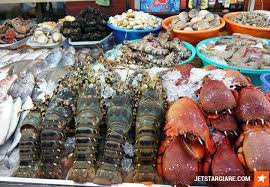Phu Quoc has been a sleepy historical backwater for most of its history. However, in the 20th century, it was involved in a series of high-profile events:
The French missionary Pigneau de Behaine used the island as a base during the 1760s and 1780s to shelter Nguyễn Ánh who was hunted by the Tây Sơn army.[8]
An 1856 record mentions the island: "... King Ang Duong (of Cambodia) apprise Mr. de Montigny, French envoy in visit to Bangkok, through the intermediary of Bishop Miche, his intention to yield Phu Quoc to France.[9] Such a proposition aimed to create a military alliance with France to avoid the threat of Vietnam on Cambodia. The proposal did not receive an answer from the French.[10]
While the war between Vietnam, France, and Spain was about to begin, Ang Duong sent another letter, dated November 25, 1856, to Napoleon III to warn him on Cambodian claims on the lower Cochinchina region: the Cambodian king listed provinces and islands, including Koh Trol (Phú Quốc), being parts of Vietnam for several years or decades (in the case of Saigon, some 200 years according to this letter). Ang Duong asked the French emperor to not annex any part of these territories because, as he wrote, despite this relatively long Vietnamese rule, they remained Cambodian lands. In 1867, Phu Quoc's Vietnamese authorities pledged allegiance to French troops just conquering Hà Tiên.
In 1939, the Governor-general of French Indochina, Jules Brévié drew a line to delimit the administrative boundaries for islands in the Gulf of Thailand: those north of the line were placed under Cambodia protectorate; those south of the line were managed by the colony of Cochinchina. Brévié made the point that the decision merely addressed administrative task, and that no sovereignty decision had been made.[11] As a result, Phu Quoc remains under Cochinchina administration. Later, Cochinchina's sovereignty was hanged over to the State of Vietnam and remained so after France left.
After Mainland China fell under the control of the Chinese Communist Party in 1949, General Huang Chieh moved 33,000+ Republic of China Army soldiers mostly from Hunan Province to Vietnam and they were stationed at Phu Quoc. Later, the army moved to Taiwan in June 1953.[12]
During the Vietnam War the island housed South Vietnam's largest prisoner camp (40,000 in 1973), known as Phú Quốc Prison.[13]
On May 1, 1975, a squad of Khmer Rouge soldiers raided and took Phu Quoc, but Vietnam soon recaptured it. This was to be the first of a series of incursions and counter-incursions that would escalate to the Cambodian–Vietnamese War in 1979. Cambodia dropped its claims to Phu Quoc in 1976.[14] But the bone of contention involving the island between the governments of the two countries continued, as both have an historical claim to it and the surrounding waters. A July 1982 agreement between Vietnam and The People's Republic of Kampuchea ostensibly settled the dispute, but since Vietnam's withdrawal from Cambodia, the agreement has not been recognized and the island is still the object of irredentist sentiments.[15] The opposition Cambodian National Rescue Party still claims the island as Cambodian territoryBy: https://en.wikipedia.org
































